Comic Strip Spread
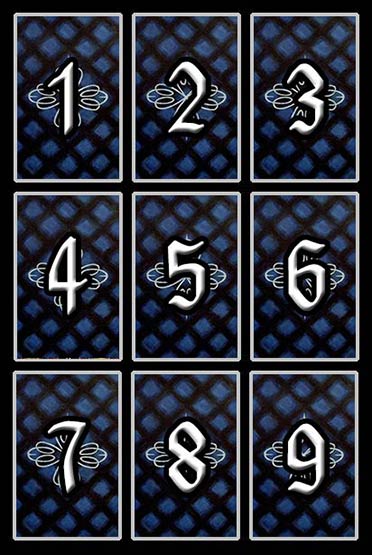
Difficulty: Easy
Note: This spread works best with decks like the Diary of a Broken Soul or Surrealist Tarot because they display scenes rather than pips and do not use reversals.
The Comic Strip Spread is a simple nine-card chronological spread that looks like a page of a comic book. This method should be used to get a glimpse of the future as it would pan out naturally. It may be insightful to use this spread in coordination with biorhythms. The spread is easy to read as a storyboard, just like a comic strip.
The main subject is apparent in the first card, while the story plays out through the following tarot cards.
It is important to pay particular attention to the cards and the relationships with their neighbours. Notice which directions the cards are facing, and how they interact.
Your Comic Strip Reading
10 of Wands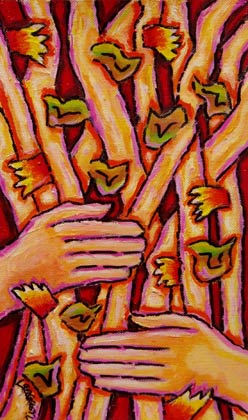 |
5 of Coins |
Strength |
4 of Swords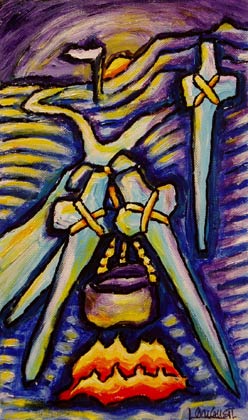 |
Ace of Cups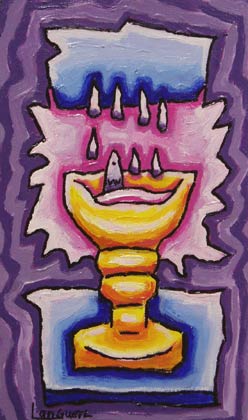 |
The Fool |
The High Priestess |
2 of Coins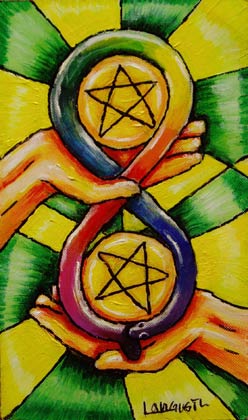 |
Ace of Swords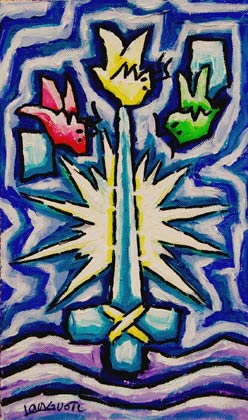 |

Card 1: 10 of Wands
The intensity of the Nine of Wands diminishes in the Ten of Wands. The colours are paler; it seems more difficult to hold the wands together; at the same time the small flames are burning both hands, the leaves are beginning to wither.

Card 2: 5 of Coins
Wealth and poverty are separated by a wall. The rich man is wearing white gloves. He doesn't want to get his fingers dirty. The poor man has a missing middle-finger, the centre has been lost. His stick is brittle.
The colour blue separates the colours red and yellow from brown and green. The yellow is similar to gold. Red used to belong to the most expensive colours. Green is also the colour of mould and brown is the colour which at first appears to be inert.
The candle is helping the poor man to find sense and the distant path, as far as he is aware of them.

Card 3: Strength
A sceptre and a sword seem to be fighting. Water and fire, portrayed in striking red, stand for subconscious strength. They are kept under control by the symbols of earth and air, the conscious elements, portrayed by the sword (clarity), the house (stability) and the wall (limits, firmness). The violet colour of the wall also shows a penetration of the colours red and blue.
The trees also contain this mixture of the elements, but they are growing cautiously as well as the clouds, water, which so to speak, becomes air (gaseous). They also stand for integration, which on the one hand makes us more flexible but on the other hand obscures things. The lemniscates, which can be seen clearly in magic, can be found in the two trees in the top left corner. It illustrates swinging into the next bend.

Card 4: 4 of Swords
Three swords are holding a violet cauldron, under which a fire is burning. Something is being "extracted". The violet colour indicates a spiritual process. The sun is setting; nothing more will happen today. To sleep on it will help.
Tomorrow it might be possible to grasp the fourth sword and to take the right path in further conflicts. The path past the white flag is also possible.

Card 5: Ace of Cups
Water is formed from a cloud, due to condensation, and is dripping into a cup. Through this the relationship between water and its opposite energy air is portrayed. If we look carefully all the four elements are present here: water=Water, cup= Earth, cloud= Air and the liberated energy = Fire.

Card 6: The Fool
The bright colours symbolise many possibilities. The Fool is holding the pilgrim's staff in his hand. Water and fish indicate openness and vivacity. The butterflies also indicate different ideas and a joy of living.
The golden yellow background gives the scene energy of life. One can see the tip of the Fool's cap. The cross, or rather the handle of the sword in the background, gives an awareness of danger, which is lurking along the path the Fool is going to take.

Card 7: The High Priestess
The two eyes indicate that the High Priestess perceives the polarity in their dualism but doesn't take any valuation into account. The light and the dark side can be seen, as well as the waning and waxing moon and the full-moon, which unites and contains both sides.
The water and the two fish also symbolise the connection, the flow of energy and the dualism. The feather stands for the High Priestess' sensitiveness, the pomegranate for her fertility.

Card 8: 2 of Coins
The picture is based on a classical presentation. The alternation is portrayed by the changing of the green and yellow colours and in addition through the movement the snake makes around the two pentacles, fashioned in the circle of colours. This appeals to a repetition of experiences. The double loop relates to our entire path through life.

Card 9: Ace of Swords
The sword is rising out of the water. The blue colour in the picture symbolises clarity. The three different coloured butterflies indicate different thoughts and the perception of difference. One butterfly is sitting on the tip of the sword, a symbol of decision. The halo supports the impression of clarification and purification.
